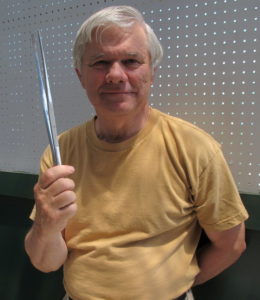Time for Succulents!
 The National Capital Cactus and Succulent Society participated in our recent Garden Party, and gave us a chance to reconsider these plants that seem to be better suited to a hotter, dryer climate than ours. But now the Mid-Atlantic is feeling more like Arizona every year, these super-drought-tolerant plants that love heat and sun are worth a second look.
The National Capital Cactus and Succulent Society participated in our recent Garden Party, and gave us a chance to reconsider these plants that seem to be better suited to a hotter, dryer climate than ours. But now the Mid-Atlantic is feeling more like Arizona every year, these super-drought-tolerant plants that love heat and sun are worth a second look.
Bob Stewart, shown right with the tweezers he recommends for weeding around the thorniest of cacti, has a few recommendations for growing succulents. One is to give them plenty of sun and excellent drainage, especially with plants that are only marginally hardy here. The other tip for those adventures in marginal hardiness is to start with large plants – they’re worth it.
 Bob also recommends this book – Hardy Succulents by Gwen Moore Kelaidis with photos by Saxon Holt. I’ve read it myself and found the text inspiring and the photos drool-worthy, and note that it’s helped many of us try more of these plants. The author has grown the plants she writes about in New York, Wisconsin and Colorado, so I believe her when she says they’ll survive the half-hearted winters of Maryland.
Bob also recommends this book – Hardy Succulents by Gwen Moore Kelaidis with photos by Saxon Holt. I’ve read it myself and found the text inspiring and the photos drool-worthy, and note that it’s helped many of us try more of these plants. The author has grown the plants she writes about in New York, Wisconsin and Colorado, so I believe her when she says they’ll survive the half-hearted winters of Maryland.
Sedums – Got ’em, Love ’em
Sedums are so easy to grow they’ve the most commonly used succulent in our area, especially the taller ‘Autumn Joy’ and its cousins ‘Matrona’ and ‘Neon’. Yep, got ‘em, and recommend them all the time as among the most sustainable perennials in the world for almost any situation. I even have a big collection in pots on my deck, and they take total neglect quite happily. But here’s what I just learned from Kelaidis – there are sedums that prefer shade. Gotta check into that.

Ice Plants – Want ’em
This book also explained for me why I don’t often see see ice plants grown here in the Mid-Atlantic – they balk at clay and need a rock garden-type medium to grow in, like sand and gravel. And I found this interesting – that although they come from tropical South Africa, ice plants have retained their residual hardiness from back in the era before the continents drifted apart, when Africa was farther north.
Cacti
True desert plants are harder to fit design-wise in Eastern gardens, to my eyes. Same goes for yuccas, which are grown around here. So if like a challenge, go for it, and this book will help you in expanding your options.
Thumb’s Up for the Book
This book can be a great help to gardeners in the Age of Climate Change. The practical advice even includes which plants are affordable in which situations and design ideas that take cost into consideration (thank you!). It’s clear that the author actually grows these plants herself, including 200+ varieties of what she lovingly calls “semps”. (The nickname alone makes me want some Sempervivums.)
Oh, and the photographer tells me that many of the photos in the book were taken in Maryland.
Posted by Susan Harris.

This Post Has 0 Comments